Dealing with bunions, or as the docs call it, hallux valgus? You’re not alone. Many veterans face this pesky foot issue thanks to years of wearing tight boots and enduring long marches. The good news? You might be eligible for VA disability benefits.
The process can seem like a maze. But stick around—I’ll break down everything you need to know about getting your condition recognized by the VA. Let’s dive into those all-important steps that’ll help keep your claim out of that dreaded spam folder.

What Is Hallux Valgus (Bunions)?
If you’re a veteran struggling with painful, bony bumps at the base of your big toe, you might be dealing with hallux valgus – aka bunions. This common foot condition can make everyday activities a real challenge.
Causes of Hallux Valgus
So what causes this pesky problem? Hallux valgus often develops gradually due to factors like genetics, arthritis, or wearing ill-fitting shoes. But for many veterans, the culprit is the constant physical stress of military service. Think about it – all those hours marching in rigid boots, carrying heavy gear, jumping out of planes… it’s no wonder our feet start to rebel. I’ve seen countless veterans who trace their bunion woes back to their active duty days. The unforgiving footwear and repetitive impact can really do a number on the delicate bones and joints in our feet, leading to that classic big toe joint deformity over time.

Symptoms of Hallux Valgus
The hallmark signs of hallux valgus are hard to miss. You’ve got that telltale bony bump jutting out at the base of the big toe. The toe itself starts to drift inward, getting all cozy with its neighboring digits. Ouch. As the bunion progresses, you might notice swelling, redness, and a deep, throbbing ache in your big toe joint. Slipping on shoes can become a real ordeal, and walking any distance feels like a marathon. Sound familiar? Yeah, hallux valgus is no joke.
Diagnosis of Hallux Valgus
If you suspect you’ve got a bunion brewing, it’s time to enlist the help of a trusty doc. They’ll give your feet a thorough once-over, checking for that characteristic bump and any wonky toe alignment. X-rays can confirm the diagnosis and reveal the severity of the deformity. Getting that official diagnosis is crucial for veterans seeking disability benefits. You’ll need to connect the dots between your hallux valgus and your military service, showing how it impacts your daily life. More on that later – for now, just know that a solid diagnosis is your first step towards getting the compensation you deserve.
VA Disability Ratings for Hallux Valgus
Alright, let’s talk turkey. If your hallux valgus can be linked to your time in uniform, you may be eligible for VA disability benefits. The VA rates this condition under diagnostic code 5280, with a maximum rating of 10%. Here’s the scoop:

10% Rating for Hallux Valgus
To snag that 10% rating, you’ll need to show that you’ve had surgery to correct your bunion, specifically a resection of the metatarsal head. Basically, if you’ve gone under the knife to shave down that bony prominence and realign your toe joint, you’ve met the criteria. Now, what if you haven’t had surgery, but your bunion is so severe that it’s essentially equivalent to an amputation of the big toe? Yep, that qualifies for a 10% rating too. Essentially, if your hallux valgus is so gnarly that you can’t even use your big toe anymore, the VA acknowledges that loss of function.

20% Rating for Hallux Valgus
Trick question – there is no 20% rating for hallux valgus. The highest you can go under this particular diagnostic code is 10%. However, that doesn’t mean you’re out of luck if your bunion is severely impacting your quality of life.
Severe Hallux Valgus Rating
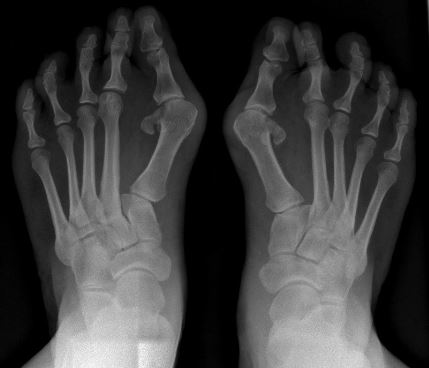
If your hallux valgus is so severe that it’s causing major problems with employment or daily activities, you may be able to make a case for a higher rating under a different diagnostic code. It’s all about showing the full extent of your disability and how it’s holding you back. For instance, let’s say your bunion is so painful that you can barely walk, much less hold down a job that requires standing or physical labor. In that case, you might explore additional ratings for secondary conditions like hammertoes, plantar fasciitis, or even unemployability. The key is to paint a complete picture of how your hallux valgus affects every aspect of your life. Don’t downplay your symptoms or try to tough it out – the VA needs to understand the true impact of your condition.
Service Connection for Hallux Valgus
Now, here’s the million-dollar question: how do you prove that your hallux valgus is connected to your military service? It’s not always as straightforward as pointing to a specific injury or event, but there are a few paths to service connection.

Direct Service Connection
The most obvious route is direct service connection. If you can show that your bunion first reared its ugly head during your time in uniform, or that it was caused by a specific incident or injury during service, you’ve got a strong case. Maybe you started noticing that painful bump after a grueling 12-mile ruck march, or perhaps you took a tumble during an obstacle course and jammed your toe. If you sought treatment for foot pain or a toe injury while on active duty, that’s a big point in your favor. The key is to gather any and all evidence that ties your hallux valgus directly to your service. That could include medical records, buddy statements from fellow service members who witnessed your foot problems, or even photos of you rocking those stylish combat boots.

Secondary Service Connection
But what if your bunion didn’t develop until after you hung up your uniform? Don’t despair – you may still be able to establish service connection on a secondary basis. Here’s how it works: let’s say you’ve already got a service-connected disability, like a knee or back condition, that alters your gait or requires you to wear special shoes. Over time, that altered biomechanics can put extra stress on your feet, leading to the development of hallux valgus. In that scenario, your bunion is considered secondary to your original service-connected disability. You’ll need to provide medical evidence showing the link between your primary condition and the development of your hallux valgus, but it’s a viable path to getting the benefits you deserve.
Aggravation of Pre-existing Condition

Okay, last but not least – what if you had a mild bunion before you ever put on a uniform, but your time in service made it a whole lot worse? That’s where aggravation comes in. If you can demonstrate that the rigors of military life – all that marching, running, and jumping – caused your pre-existing hallux valgus to progress beyond its natural course, you may be eligible for service connection based on aggravation. You’ll need to provide evidence of the severity of your bunion before and after service, along with a medical opinion stating that your military duties accelerated the condition beyond what would be expected with normal wear and tear. It’s a tricky argument to make, but with the right evidence and a skilled advocate in your corner, it’s definitely worth pursuing. After all, you served your country faithfully – you deserve to be compensated for the toll it took on your body.
Key Takeaway:
Veterans with hallux valgus (bunions) can seek VA disability benefits if their condition is linked to military service. Diagnosis involves a medical exam and possibly X-rays. A 10% rating applies for surgery or severe cases equating to big toe amputation, but more complex situations might warrant higher ratings under different codes.
Common Secondary Conditions Associated with Hallux Valgus
Hallux valgus is no joke. It can lead to a whole host of other issues that make life even more miserable.
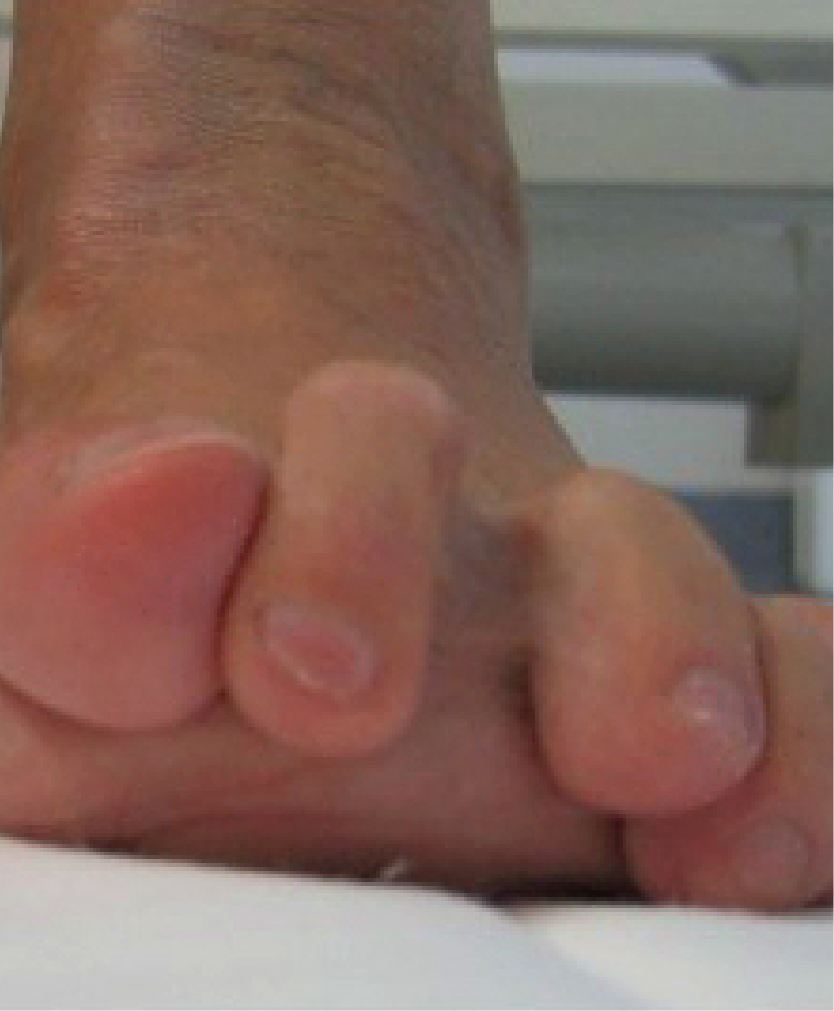
By User:Bprender22 – Own work by the original uploader, Public Domain, https://commons.wikimedia.org/w/index.php?curid=69029387
Hammer Toe
Take hammer toe, for instance. It’s a deformity where one or more of the smaller toes becomes bent at the middle joint, causing the toe to curl downward. Hallux valgus can contribute to the development of hammer toes by forcing the smaller toes into a bent position due to the misalignment of the big toe.
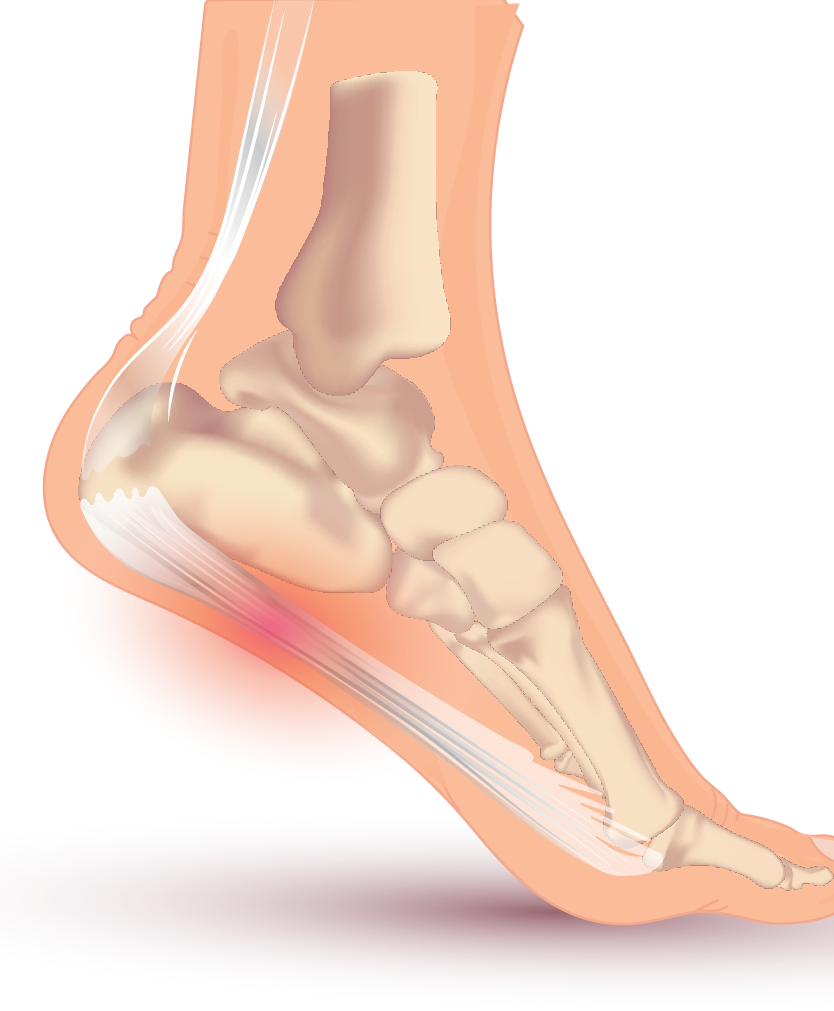
InjuryMap, CC BY-SA 4.0 <https://creativecommons.org/licenses/by-sa/4.0>, via Wikimedia Commons
Plantar Fasciitis
Then there’s plantar fasciitis, an inflammation of the band of tissue that runs along the bottom of the foot. The altered foot mechanics caused by hallux valgus can place additional strain on the plantar fascia, potentially leading to plantar fasciitis as a secondary condition.
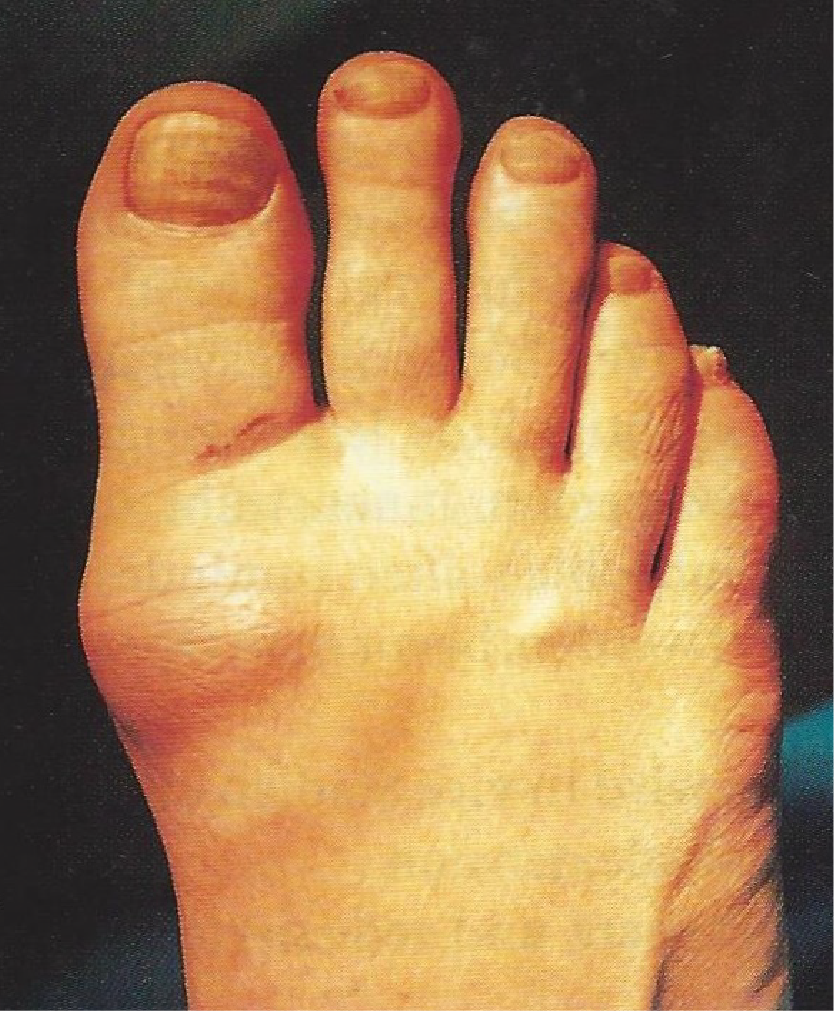
<a href=”https://commons.wikimedia.org/wiki/File:Hallux_rigidus_(klin.).jpg”>Mehlauge</a>, <a href=”https://creativecommons.org/licenses/by-sa/3.0″>CC BY-SA 3.0</a>, via Wikimedia Commons
Hallux Rigidus
Hallux rigidus is a form of arthritis that affects the joint at the base of the big toe, causing pain and stiffness. Severe hallux valgus can contribute to the development of hallux rigidus over time due to the abnormal positioning and stress on the big toe joint.
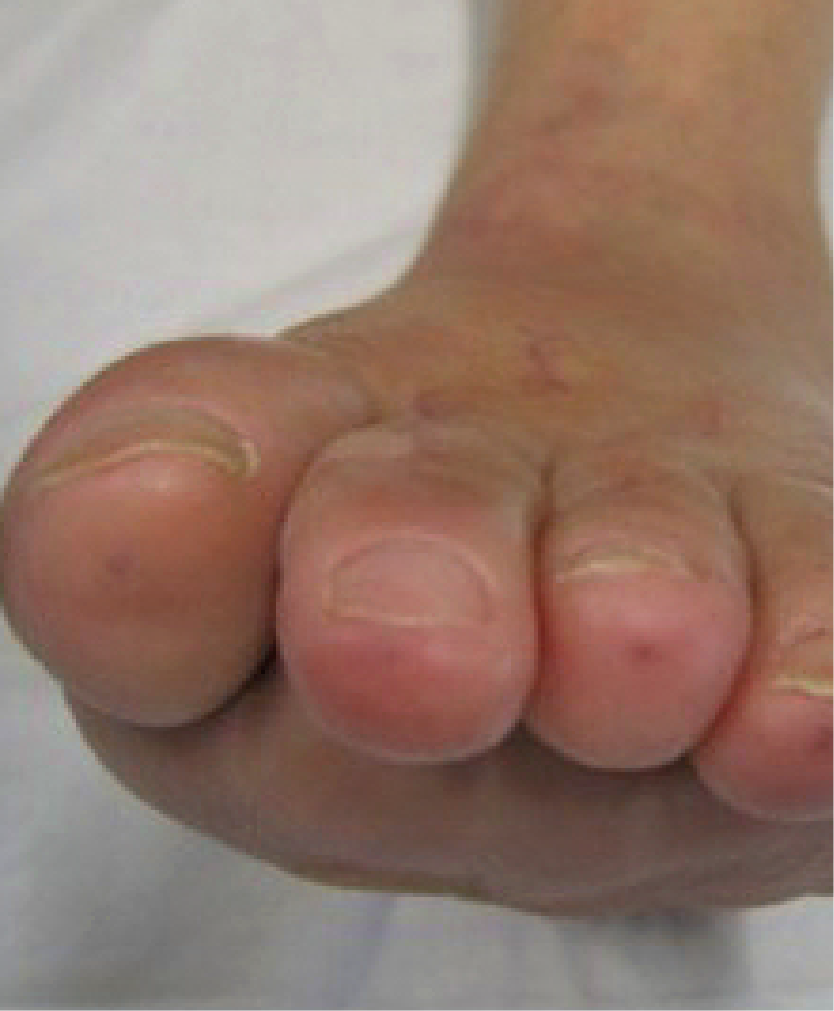
<a href=”https://commons.wikimedia.org/wiki/File:Luxierte_Zehen_bei_Rheumatoidarthritis_(pr%C3%A4op.)..jpg”>Angela Simon</a>, <a href=”https://creativecommons.org/licenses/by-sa/3.0″>CC BY-SA 3.0</a>, via Wikimedia Commons
Rheumatoid Arthritis
While rheumatoid arthritis is an autoimmune condition that is not directly caused by hallux valgus, veterans with RA may be more susceptible to developing bunions due to the inflammatory changes in their joints. The presence of both conditions can compound the impact on a veteran’s foot health and mobility.
Compensation and Pension Exam for Hallux Valgus
If you’re seeking VA disability benefits for your hallux valgus, you’ll likely need to undergo a Compensation and Pension (C&P) exam. Here’s what you can expect:

What to Expect During the Exam
During the exam, the examiner will assess the severity of your bunion condition. They’ll examine your feet, check for any deformity, tenderness, or limited motion, and may order imaging tests. The examiner will also ask about your symptoms and how the condition affects your daily activities.
Providing Medical Evidence
To help establish the severity and impact of your hallux valgus during the C&P exam, provide any relevant medical records, treatment notes, or supporting statements from healthcare providers. This evidence can help support your claim for a higher disability rating.
Importance of Attending the Exam
Attending the C&P exam is crucial if you’re seeking VA disability benefits for hallux valgus. If you don’t show up without good cause, the VA may deny your claim. The exam is your chance to have your condition evaluated and discuss the functional limitations caused by your bunions.
Impact of Hallux Valgus on Daily Life and Employment

Hallux valgus can wreak havoc on your daily life and ability to work. Here’s how:
Limitations in Daily Activities
Severe hallux valgus can significantly impact your daily life by causing pain and difficulty with walking, standing, or wearing shoes. These limitations can affect your ability to perform household chores, engage in recreational activities, or take care of your personal needs.
Impact on Employment
Hallux valgus can interfere with your ability to work, especially if your job requires prolonged standing, walking, or physical labor. The pain and limited mobility caused by bunions may require work restrictions or accommodations. In severe cases, it may prevent you from maintaining substantially gainful employment altogether.
Eligibility for TDIU
While hallux valgus alone may not be rated high enough to qualify for Total Disability based on Individual Unemployability (TDIU), it can contribute to your overall disability picture. If your service-connected disabilities, including hallux valgus, prevent you from securing or following substantially gainful employment, you may be eligible for TDIU benefits. The bottom line? Hallux valgus is no walk in the park. It can lead to a host of secondary conditions, impact your daily life, and even affect your ability to work. If you’re a veteran dealing with this painful condition, don’t hesitate to seek the disability compensation you deserve.
Key Takeaway:
Hallux valgus can lead to secondary issues like hammer toe, plantar fasciitis, and hallux rigidus. It impacts daily life and work ability. Attending the C&P exam is crucial for VA disability benefits.
Conclusion
So there you have it—the essentials on VA Disability Ratings for Hallux Valgus (Bunions). It’s more than just paperwork; it’s about recognizing how much you’ve endured during service.
If you’re struggling with daily tasks because of bunion pain, remember that support is available through the VA system. Don’t let red tape discourage you from claiming what’s rightfully yours.
This journey isn’t just about compensation—it’s also a step towards better health management and improving quality of life.
You’ve got this!


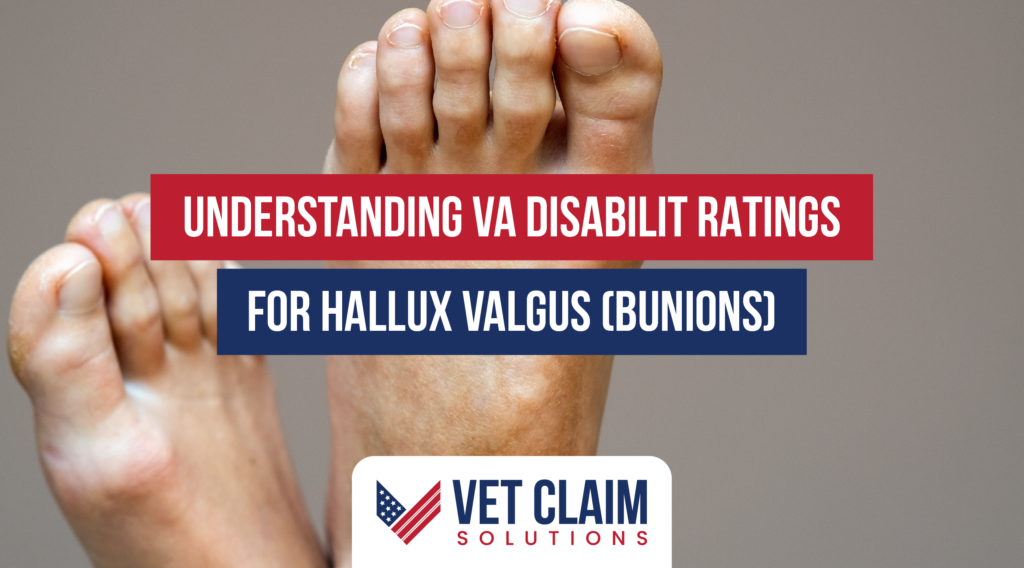
This Post Has 2 Comments
I read your opinion on HALLUS VALGUS (BUNION).
I had surgery several times on both feet. Have a 40% Rating. Prior to getting Service Connected, I BASICALLY HAD STOP WORKING, couldn’t stand on my Feet for Long Periods, end up using a Walking Kane. At times the feet hurt so much I leaned on the Kane to take weight off my feet, (SOMETIMES LEFT OR RIGHT HAND DEPENDS ON WHAT FOOT HURTED THE MOST).
I say this because……My Feet and The Usage of the Kane has Brought some Secondary Conditions, These are
1 & 2) L and R Shoulders,
3 & 4) L and R Shoulder Blades,
5 & 6) Upper and Lower Back,
7 & 8) L and R Hips,
9 & 10) L and R Knees…. Mostly the (R),
11 & 12) L and R Wrists
13 & 14) L and R Hands.
These are Secondary Conditions to My Service Connected Disability. Because of BOTH FEET Having HALLUS VALGUS, this INTURN cause THE HEAVY LEANING on THE WALKING KANE, which inturn, OVER THE YEARS BROUGHT ABOUT THESE SECONDARY CONDITIONS. I also use a Walker at times.
I have been Medically Treated for All of Secondary Conditions, getting Documentation isn’t a Problem.
QUESTION;
Is there someone whom I can inquire, as to how to Get Help with Upgrading My Service Connected Disability, by Filing for These Secondary Conditions.
I read your opinion on HALLUS VALGUS (BUNION).
I had surgery several times on both feet. Have a 40% Rating. Prior to getting Service Connected, I BASICALLY HAD STOP WORKING, couldn’t stand on my Feet for Long Periods, end up using a Walking Kane. At times the feet hurt so much I leaned on the Kane to take weight off my feet, (SOMETIMES LEFT OR RIGHT HAND DEPENDS ON WHAT FOOT HURTED THE MOST).
I say this because……My Feet and The Usage of the Kane has Brought some Secondary Conditions, These are
1 & 2) L and R Shoulders,
3 & 4) L and R Shoulder Blades,
5 & 6) Upper and Lower Back,
7 & 8) L and R Hips,
9 & 10) L and R Knees…. Mostly the (R),
11 & 12) L and R Wrists
13 & 14) L and R Hands.
These are Secondary Conditions to My Service Connected Disability. Because of BOTH FEET Having HALLUS VALGUS, this INTURN cause THE HEAVY LEANING on THE WALKING KANE, which inturn, OVER THE YEARS BROUGHT ABOUT THESE SECONDARY CONDITIONS. I also use a Walker at times.
I have been Medically Treated for All of Secondary Conditions, getting Documentation isn’t a Problem.
QUESTION;
Is there someone whom I can inquire, as to how to Get Help with Upgrading My Service Connected Disability, by Filing for These Secondary Conditions.